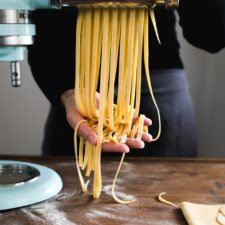Beginner's Guide to Fresh Homemade Pasta Dough
5.0
(10)
Your folders
Your folders
Prep Time: 1 hours
Total: 1 hours
Servings: 4
Author : Emilie Raffa

Ingredients
Export 9 ingredients for grocery delivery
Instructions
Step 1
Add the flour to a large bowl. Make a well in the center; add the eggs and yolk.
Step 2
Whisk together with a fork, and then combine with the flour. When the texture becomes stiff, finish by hand to form a rough dough. If dry bits of flour remain after a few minutes of mixing (be patient, it’s a dry dough) add a few drops of water or olive oil to bring the dough together.
Step 3
Form the dough into a ball, cover with an upturned bowl or with plastic wrap, and let rest at room temperature for 10-15 minutes- it will be easier to knead.
Step 4
Knead the dough for 5-7 minutes. Do this by folding the dough over itself, pushing it forward with the heel of your hand, turning slightly as you go. I literally rock the dough back and forth (watch the video). The texture will be very stiff at first- it’s not bread dough. But rest assured, by the 2 minute mark it will start to soften. Keep kneading until the dough is soft, malleable and has a talcum-like finish. It should “bounce back” slowly when poked.
Step 5
Form the dough into a ball, cover tightly with plastic wrap, and rest at room temperature for 30 minutes.
Step 6
On your work surface, cut the pasta dough into 4 pieces. Working with one piece at a time, flatten the dough into a 6-8inch oval patty. Keep the remaining doughs covered in wrap otherwise they will dry out.
Step 7
Set the pasta roller to #1 which is the lowest/widest setting on the Kitchen Aid. With the machine running, send the dough through the roller. Now, send it through again (so, 2x total). Note: if you are using a hand crank pasta machine, refer to the manufacture’s specific instructions for rolling the dough- the settings might differ but the process is the same.
Step 8
Continue to roll the dough through settings #2-4, (2x) on each setting. Do not pull on the sheet as it comes through the roller; just guide it along gently. If at any point the dough becomes sticky, dust with semolina flour. I keep my work surface dusted with semolina at all times. This way I can coat both sides of my pasta sheet easily and quickly while I work.
Step 9
Your pasta sheet is ready when it’s beautifully thin and somewhat translucent (you should be able to see your hand underneath). Don’t worry if the ends are not perfectly straight; you can always trim them with a knife.
Step 10
To finish, dust the pasta sheet generously with semolina, fold it in half, and place onto your floured sheet pan. Cover with a kitchen towel. Repeat the rolling process for the remaining 3 doughs.
Step 11
Before cutting, I like to dry my pasta sheets ever so slightly. This firms up the final texture giving the strands a more “leathery” finish, rather than a soft and doughy feel (this will prevent the pasta from sticking together later on).
Step 12
drape the pasta sheets over the back of a chair for about 10-15 minutes or so. Keep your eye on the time; you don’t want the sheets to dry out completely. You will be able to feel the difference.
Step 13
take a pasta sheet and cut it in half. Trim the ends, if you like. Run the sheet through your desired pasta cutter attachment to create strands. Alternatively, cut the dough by hand.